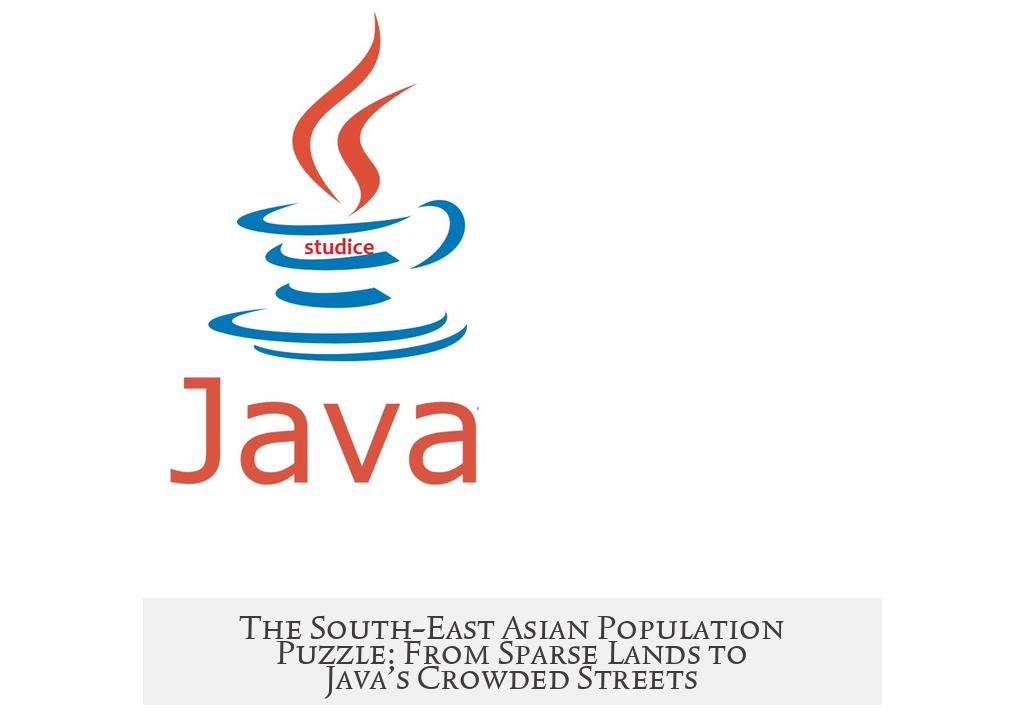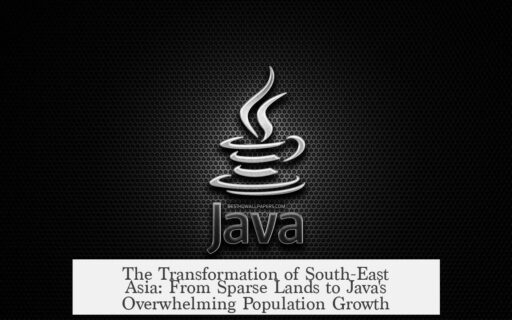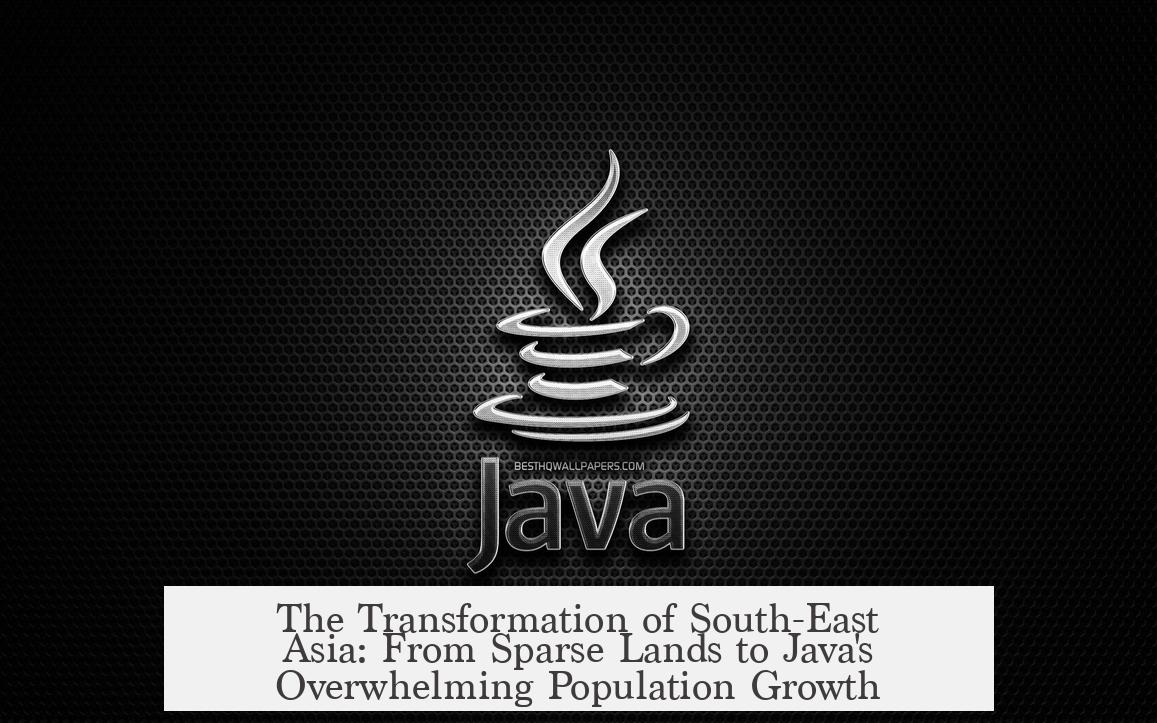South-East Asia, particularly Indonesia and Java, was once sparsely populated, but today Indonesia ranks as the fourth most populous country globally, with Java alone hosting over 100 million people. What changed fundamentally lies in population growth dynamics, historical census revisions, and agricultural advancements.
Historically, Java’s population appeared to explode rapidly in the early 19th century. This growth was initially attributed to improved public health measures such as smallpox vaccinations and reduced warfare under Dutch colonization. However, more recent historical research suggests that early censuses, like the one conducted by Stamford Raffles in 1815, significantly undercounted the population. Raffles’s census reported around 4.5 million people, but later studies estimate that Java’s population was closer to 8–10 million around 1800. This means the early population density was approximately 72 people per km2, which by today’s standards is sparse and comparable to modern Ireland.
Java covers only 7.3% of Indonesia’s land but houses about 56% of its population. The population density there reaches roughly 1,092 people per km2, far surpassing the Indonesian average of 143 people per km2 and the 69 people per km2 outside Java. Since 1800, Java’s population has multiplied around 15 times, reaching approximately 151.6 million today.
The main drivers behind this growth include:
- Reduction in mortality rates due to better disease control and treatment.
- Expanded and improved agriculture, especially from the mid-20th century onward.
- Introduction of advanced crop varieties, better irrigation systems, fertilisers, and pesticides.
This agricultural revolution allowed Java to sustain a much larger population by increasing food production, enabling a population boom. Similar growth patterns occurred in other parts of South-East Asia, such as Thailand.
This shift reveals a transition from an initially underestimated, relatively sparse population to a densely populated region driven by health improvements and technological advancements in farming.
- Early census data underestimated Java’s population substantially.
- Java’s population grew about 15-fold since 1800.
- Disease control and agricultural improvements fueled growth.
- Java is densely populated compared to the rest of Indonesia.
The South-East Asian Population Puzzle: From Sparse Lands to Java’s Crowded Streets

Is it really true that South-East Asia used to be sparsely populated, and how did Indonesia become the 4th most populous country with Java housing over 100 million people? The short answer: what’s changed is a perfect storm of improved health, agricultural advances, and, well, some census math!
Let’s unpack this fascinating transformation that rewrites how we think about population growth and density in this vibrant region.
South-East Asia: Sparse Yesterday, Bustling Today?
Historically, parts of South-East Asia were indeed considered sparsely populated. If you picture sprawling jungles and quiet villages, you’re not too far off. Yet, fast forward to today, and the story shifts dramatically.
Indonesia, a sprawling archipelago of over 17,000 islands, now ranks fourth in the world for population size. Java, one of its islands, hosts a staggering 1092 people per square kilometer! To put that in perspective, the entire country has a density of about 143 people/km2, but Java’s tiny area – just 7.3% of Indonesia’s land – supports more than 56% of the total population. Java is an outlier: a mega population hub packed into a modest space.
So, What Changed in Java’s Population Story?

The story of Java’s rapid population rise often centers on the 19th century. Early observers called it a “population explosion,” linked to smallpox vaccination and peace brought by Dutch colonial rule. These factors reduced death rates and stopped frequent local wars. This should have meant steady growth, right?
Well, hold your horses — and your census forms. Modern historians suggest that the supposed “explosion” was exaggerated. Early census data were sketchy. Take Stamford Raffles’s 1815 census reporting only about 4.5 million people. Later research shows that number was way off, likely under-counting children and households dramatically. Instead, by correcting the records, experts estimate Java had between 8 and 10 million people around 1800.
That means Java’s density back then was about 72 people per km2, similar to modern Ireland—not exactly a ghost town, but still pretty sparse compared to today’s jam-packed reality.
Java’s Growth: Slow and Steady, then Skyrocketing
Since 1800, the population ballooned about 15 times, reaching roughly 151 million today. Imagine watching a modest garden turn into a bustling, crowded city block on steroids.
This dramatic increase mirrors trends in places like Thailand, which also experienced a 15-fold rise since 1800. The difference? Java concentrated so much of that population in a small space.
What Drove This Incredible Growth?

Three major forces transformed Java from lightly settled to densely populated:
- Disease Reduction: Medical advances dramatically cut death rates. Vaccinations, better sanitation, and disease control became game-changers.
- Improved Agriculture: In the 20th century, enhanced crop varieties, irrigation, fertilisers, and pesticides boosted food production. Suddenly, the land could sustain many more people.
- Political Stability: Peaceful periods allowed stable communities to flourish without frequent setbacks from conflict.
Java’s population was about 50 million in 1950. The mid-20th century agricultural revolution helped to sustain this growing population. Without enough food and resources, a mega population hub like Java couldn’t have survived.
Why Is Java So Different From the Rest of Indonesia?
Remember, Indonesia’s overall population density is just 143 people/km2, but exclude Java, and this drops to 69 people/km2. That means the rest of Indonesia remains much more lightly populated.
Java’s geographic conditions, fertile volcanic soil, and historical investments in agriculture made it the perfect place for population to cluster. The rest of Indonesia, with its vast rainforests and mountainous terrain, didn’t experience the same intense demographic pressure.
So, Should We Ditch the “Population Explosion” Story?

Not quite. Java’s population growth was real and significant—but the narrative about an “explosion” mainly arose from early census inaccuracies. Understanding data limitations helps us see that growth was more of a sustained climb than a sudden spike.
Still Curious? Dive Deeper
If you want to geek out further, scholars like H. de Meel and Bram Peper provide valuable insights:
- Meel, H. de. “Some Aspects of the Population Problem in Java” in The Australian Quarterly, 1951, explores mid-20th century demographic challenges.
- Peper, Bram. “Population Growth in Java in the 19th Century: A New Interpretation” in Population Studies, 1970, dissects the inaccuracies behind early census data.
Wrapping Up: What Can We Learn?
The change from sparse to dense in South-East Asia, especially Java, isn’t a tale of overnight boom but a story of gradual, complex evolution. It involves improved health, better farming, stable governance, and a lot of head-scratching over old data.
So next time you hear that Java “exploded” in population, remember: it was more a marathon than a sprint. And that “sparse” South-East Asia of yesteryears has grown into a bustling region shaping the global scene.
What does this mean for today? Well, managing such dense areas challenges urban planning, infrastructure, and resources. But it also means vibrant cultures, bustling cities, and an energetic population that keeps the region dynamic.
Is Java’s story unique? To some extent, yes. Its geography, history, and development path provide a vivid case study in how population dynamics evolve. Understanding these forces can help policymakers and planners create sustainable futures for both dense urban islands and the sprawling rural archipelago.




